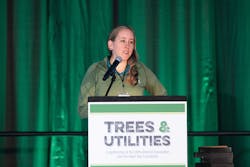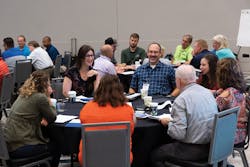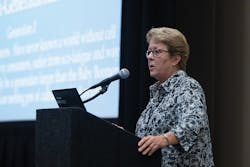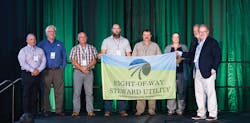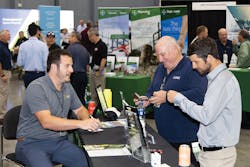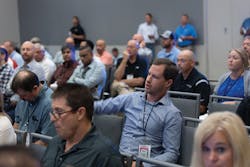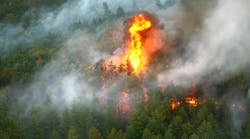At the Duke Energy Convention Center in the heart of Cincinnati, Ohio, vegetation management professionals from 44 utilities, 44 states and six countries shared strategies, expressed concerns and discussed possible solutions at the 2019 Trees & Utilities conference.
The event, which was hosted by the Utility Arborist Association (UAA) and the Arbor Day Foundation, had more than 850 attendees, which far surpassed the 500 registrations mark last year in Omaha.
“It was the largest crowd we have ever had, and I am blown away by the attendance,” said Philip Charlton, executive director of the UAA. “It is a good indicator, and it said a lot of our industry and the value of what we do as vegetation managers. Our work is critical, and there is no margin for error. It is good to see people out learning how to do their jobs better.”
Prior to the start of the conference, attendees could register for two different workshops. Iris Caldwell, P.E., a research engineer at the Energy Resources Center at the University of Illinois at Chicago, and her planning committee organized a Rights-of-Way as Habitat Working Group Meeting. Also, attendees could register for the Women in Vegetation Management Workshop, which was organized by Sara Sankowich, a past UAA president, and the Women in Vegetation Management committee. Anne Marie Moran of National Grid, Josiane Bonneau of Wildlife Habitat Council and Jennifer Arkett, who retired from Duquesne Light Company, were the featured speakers. The UAA honored Arkett, a past UAA president, with the Lifetime Achievement Award at the 2019 Trees & Utilities conference for her valuable contributions to the industry and Lindsey Boyle of PG&E with the Rising Star Award.
During the event, the attendees had the opportunity to earn continuing education credits by attending the sessions and learn about new products by meeting with 66 exhibitors during the trade show. Dan Lambe, president of the Arbor Day Foundation, said he was humbled by the size of this year’s Trees & Utilities conference.
“I remember some of the first ones in the 1990s in Nebraska City, Nebraska,” he said. “We are continuing to learn, share and continue the peer-to-peer connections in the vegetation management industry.”
Focus on Stewardship and Sustainability
With environmental stewardship as a focus of the UAA’s strategic plan, Trees & Utilities conference co-located with the meeting of the Rights-of-Way as Habitat Working Group. This network of professionals from the electric, gas, rail and road industries work with industry leaders, government agencies, academia and non-profit partners to promote the conservation of habitats along rights-of-way and other managed lands.
The workshop kicked off on Monday morning with a pollinator habitat field demonstration and hands-on training on the Ohio Department of Transportation’s right of way followed by a visit to the Cincinnati Zoo and Botanical Garden to learn about pollinator initiatives. The next day, the group met at the convention center, where they learned how to advance pollinator habitats on working lands.
During the Trees & Utilities conference, several of the sessions were also devoted to sustainability. For example, Josiane Bonneau of the Wildlife Habitat Council delivered a presentation on nature-based solutions for a resilient right of way, and Jarod Cassada from Oklahoma Gas & Electric shared his utility’s approach to promoting habitat and sustainable vegetation. In addition, John Goodfellow of BioCompliance Consulting presented a session on the cost efficiency of IVM, while Lori Nordstrom from the U.S. Fish and Wildlife Service educated the attendees about regulatory mechanisms for promoting habitat on ROWs. Roy van Houten of Wetland Studies and Solutions and Ronan Mason of TC Energy Corporation focused on integrated habitat management.
The Rights-of-Way Stewardship Council also honored those utilities who are applying integrated vegetation management practices, including AltaLink, Arizona Public Service, Bonneville Power Administration, Pacific Gas & Electric, Sacramento Municipal Utility District and Vermont Electric Power Co.
In addition, the UAA recognized organizations whose support through membership, sponsorship, active committee volunteerism, and many other means have been quantified and recognized with the Partners in Excellence Award. The Arbor Day Foundation, whose goal is to plant, nurture and celebrate trees, recognized the Tree Line USA utilities. Lambe said now is the time for utilities to get involved.
“Utilities need to work together to plant and care for trees,” Lambe said.
Overcoming the Workforce Challenge
Sustainability was not the only topic addressed. Workforce management was one of the key topics at the 2019 Trees & Utilities conference. In the United States, workers are often certified after 18 months of on-the-job training, Charlton said. The UAA, however, is working on an apprenticeship program in which the workers learn about best practices, health and safety during the first six months before they move into the contractor workforce.
During the Trees & Utilities conference, the attendees voiced their concerns about labor recruitment and retention during the Thursday morning sessions. Sankowich and Emily Kramer of ComEd shared the results from a vendor survey from the Utility Vegetation Managers Summit in May 2019. The UAA sent out a survey to 27 vendors from different regions and received responses from different parts of the country.
In their “Utility Impacts on Workforce Retention” session, Sankowich said recruiting and retaining workers is a huge issue facing the industry.
“Most of our workforce is employed by contractors, and we spent a lot of time preparing to understand how utilities could impact workforce retention,” Sankowich said.
The survey asked the respondents to rank the common reasons that employees are leaving the industry. The desire for travel and the opportunity for higher pay in an industry that is not as physically taxing ranked first, followed by more stability and advancement opportunities. To stabilize the workforce and reduce attrition, contractors stated that utilities can allow for cost-of-living increases, offer continuous contracts and base wage minimums. While the respondents stated in the poll that three years was the ideal contract length to retain employees, the attendees at the Trees & Utilities conference participating in a live poll said that five years was more preferable.
Following the summit, the UAA launched a workforce retention task force to understand the issues faced by utility line clearance contractor workers. They learned that they want respect from their own company as well as the utility company and the utility line workers, and rather than being called “tree trimmers,” they prefer the term, “arborists.”
Jordan Jozak of Tree Care of New York, LLC, the chair of the workforce retention task force, said the UAA is also working on ways to encourage more education and training in the vegetation management industry. So far, 80 people have already agreed to help with the effort, and the association is looking for more volunteers.
In addition, they discovered the importance of partnering with schools to recruit potential candidates. For example, New Brunswick Power in Canada started a program with the College of Forest Technology to build credibility and improve safety. The two-year program, which cost $20,000 per student, received 40 applicants, and 76 percent graduated. All of the graduates were hired by NB Power, and they worked for both in-house crews and contractors, which resulted in two new crews who were certified as utility arborists.
One panel focused on recruiting new workers was well as retaining employees in the vegetation management industry. Kelly Clapper, who has been in the business for 38 years, said he has a strategy to fix the problem, and he needs every utility and contractor to help him with this team effort to see results. Over the last five years, he said 54.4% of the workers in the vegetation management industry voluntarily left their positions.
“As a utility person, I would be scared to death,” said Clapper of JAFLO Trees. “I don’t see where the labor is going to come from. It is going to affect safety, and costs are going to go up.”
After his career in the industry, he said it’s his turn to give back and to help start training schools throughout the country for arborists. He said to recruit new applicants, line contractors and utilities can turn to graduating high school students and military veterans. He proposed securing federal grants to start the program.
“I see everyone talking about it, but I don’t think we are doing enough,” he said. “We have to train and keep the people in the industry, and once they get a year of training, we can guarantee them jobs.”
To keep workers within the vegetation management industry, companies need to focus on human performance, said Alex Konopka of Portland General Electric.
“This work will always be done by people, and a human will be behind a chainsaw, joystick or helicopter,” Konopka said.
Another panelist, Sara Dreiser of the Davey Resource Group, said that at her company, a lot of the employees were eager for growth, and as such, she works on developing training and mentorship programs.
“While wages are a part of the puzzle, you also need to give them a sense of autonomy, mastery and purpose, and they will stick with your company,” Dreiser said. “You also need to give them intensive training when you bring them into the workforce.”
Editor’s Note: To see a photo gallery from the conference, visit www.tdworld.com/vegetation-management.

